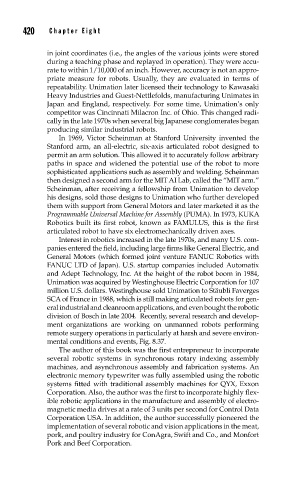Page 467 - Sensors and Control Systems in Manufacturing
P. 467
420
Cha p te r
Ei g h t
in joint coordinates (i.e., the angles of the various joints were stored
during a teaching phase and replayed in operation). They were accu-
rate to within 1/10,000 of an inch. However, accuracy is not an appro-
priate measure for robots. Usually, they are evaluated in terms of
repeatability. Unimation later licensed their technology to Kawasaki
Heavy Industries and Guest-Nettlefolds, manufacturing Unimates in
Japan and England, respectively. For some time, Unimation’s only
competitor was Cincinnati Milacron Inc. of Ohio. This changed radi-
cally in the late 1970s when several big Japanese conglomerates began
producing similar industrial robots.
In 1969, Victor Scheinman at Stanford University invented the
Stanford arm, an all-electric, six-axis articulated robot designed to
permit an arm solution. This allowed it to accurately follow arbitrary
paths in space and widened the potential use of the robot to more
sophisticated applications such as assembly and welding. Scheinman
then designed a second arm for the MIT AI Lab, called the “MIT arm.”
Scheinman, after receiving a fellowship from Unimation to develop
his designs, sold those designs to Unimation who further developed
them with support from General Motors and later marketed it as the
Programmable Universal Machine for Assembly (PUMA). In 1973, KUKA
Robotics built its first robot, known as FAMULUS, this is the first
articulated robot to have six electromechanically driven axes.
Interest in robotics increased in the late 1970s, and many U.S. com-
panies entered the field, including large firms like General Electric, and
General Motors (which formed joint venture FANUC Robotics with
FANUC LTD of Japan). U.S. startup companies included Automatix
and Adept Technology, Inc. At the height of the robot boom in 1984,
Unimation was acquired by Westinghouse Electric Corporation for 107
million U.S. dollars. Westinghouse sold Unimation to Stäubli Faverges
SCA of France in 1988, which is still making articulated robots for gen-
eral industrial and cleanroom applications, and even bought the robotic
division of Bosch in late 2004. Recently, several research and develop-
ment organizations are working on unmanned robots performing
remote surgery operations in particularly at harsh and severe environ-
mental conditions and events, Fig. 8.37.
The author of this book was the first entrepreneur to incorporate
several robotic systems in synchronous rotary indexing assembly
machines, and asynchronous assembly and fabrication systems. An
electronic memory typewriter was fully assembled using the robotic
systems fitted with traditional assembly machines for QYX, Exxon
Corporation. Also, the author was the first to incorporate highly flex-
ible robotic applications in the manufacture and assembly of electro-
magnetic media drives at a rate of 3 units per second for Control Data
Corporation USA. In addition, the author successfully pioneered the
implementation of several robotic and vision applications in the meat,
pork, and poultry industry for ConAgra, Swift and Co., and Monfort
Pork and Beef Corporation.

